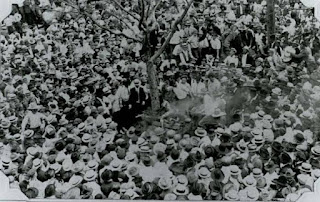Jesse Washington was a seventeen-year-old African American farmhand
Lynching of Jesse Washington May 15, 1916–world history and facts
Jesse Washington was a seventeen-year-old African American farmhand who was lynched in the county seat of Waco, Texas, on May 15, 1916, in what became a well-known example of racist lynching.
Washington was convicted of raping and murdering Lucy Fryer, the wife of his white employer in rural Robinson, Texas.
He was chained by his neck and dragged out of the county court by observers. He was then paraded through the street, all while being stabbed and beaten, before being held down and castrated. He was then lynched in front of Waco's city hall.
Over 10,000 spectators, including city officials and police, gathered to watch the attack. There was a celebratory atmosphere among whites at the spectacle of the murder, and many children attended during their lunch hour.
Members of the mob cut off his fingers, and hung him over a bonfire after saturating him with coal oil.
He was repeatedly lowered and raised over the fire for about two hours. After the fire was extinguished, his charred torso was dragged through the town.
A professional photographer took pictures as the event unfolded, providing rare imagery of a lynching in progress. The pictures were printed and sold as postcards in Waco.
Although the lynching was supported by many Waco residents, it was condemned by newspapers around the United States.
The National Association for the Advancement of Colored People (NAACP) hired Elisabeth Freeman to investigate; she conducted a detailed probe in Waco, despite the reluctance of many residents to speak about the event.
Freeman concluded that white residents were generally supportive of Washington's lynching. She also concluded that Washington killed Fryer.
After receiving Freeman's report on the lynching, NAACP co-founder and editor W. E. B. Du Bois published an in-depth report featuring photographs of Washington's charred body in The Crisis, and the NAACP featured his death in their anti-lynching campaign.
Historians have noted that Washington's death helped alter the way lynching was viewed.
The widespread negative publicity helped curb public support for the practice. In the 1990s and 2000s, some Waco residents lobbied for a monument to Washington's lynching, but this idea failed to garner wide support in the city.
On the centenary of the event, in May 2016, the mayor of Waco held a formal ceremony to apologize to Washington's descendants and the African American community. A historical marker has been installed to memorialize the lynching.
Murder and arrest
In Robinson, Texas, Lucy Fryer was murdered while alone at her house on May 8, 1916. She was found clubbed to death, sprawled across the doorway of the farm's seed shed.
It was a grisly scene that included signs of sexual assault. Officials determined a blunt instrument was used as the murder weapon. She and her husband George were English immigrants, and had become well respected in the rural community where they operated a farm.
News of the death quickly reached the McLennan County Sheriff, Samuel Fleming, who immediately investigated with a team of law enforcement officers, a group of local men, and a doctor. The doctor determined that Fryer had been killed by blunt-force trauma to the head.
The local men suspected that Jesse Washington, a seventeen-year-old black youth who had worked on the Fryers' farm for five months, was responsible. One man said that he had seen Washington near the Fryer house a few minutes before Lucy's body was discovered.
That night, sheriff's deputies traveled to Washington's home, finding him in front of the house wearing blood-stained overalls. He said the stains were from a nosebleed.
Jesse, his brother William, and their parents were taken to nearby Waco to be questioned by the county sheriff's department.
Although Jesse's parents and brother were released after a short time, he was held for further interrogation, without an attorney or his parents present.
His questioners in Waco reported that he denied complicity in Fryer's death, but offered contradictory details about his actions.
Rumors spread after Washington's arrest that the youth had been in an altercation with a white man a few days before the murder.
On May 9, Sheriff Fleming took Washington to Hill County to prevent vigilante action. The Hill County sheriff, Fred Long, questioned Washington with Fleming. Washington eventually told them he had killed Fryer following an argument about her mules, and described the murder weapon and its location.
Long brought Washington to Dallas, Texas, while Fleming returned to Robinson. Fleming soon reported that he found a bloody hammer where Washington had indicated. In Dallas, Washington dictated and signed a statement that described the rape and murder of Fryer; the confession was published the next day in Waco newspapers.
Newspapers sensationalized the murder, describing Fryer's attempts to resist Washington's attack, but the doctor who had examined her body concluded that she was killed before any assault.
A lynch mob assembled in Waco that night to search the local jail, but dispersed after failing to find Washington. A local paper praised their effort. That night, a small private funeral and burial were held for Lucy Fryer.
A grand jury was assembled on May 11 in McLennan County and quickly returned an indictment against Washington; the trial was scheduled for May 15.
The Times-Herald of Waco published a notice on May 12 requesting that residents let the justice system determine Washington's fate.
Sheriff Fleming traveled to Robinson on May 13 to ask residents to remain calm; his address was well received. Washington was assigned several inexperienced lawyers.
His lawyers prepared no defense, and noted that he appeared placid in the days before the trial.













Comments
Post a Comment